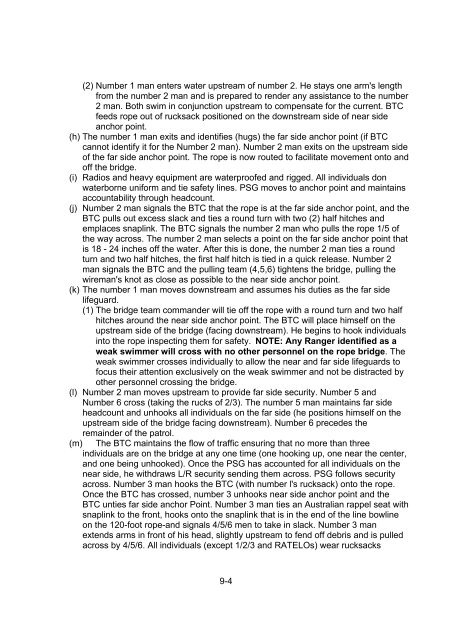Create successful ePaper yourself
Turn your PDF publications into a flip-book with our unique Google optimized e-Paper software.
(2) Number 1 man enters water upstream of number 2. He stays one arm's length<br />
from the number 2 man and is prepared to render any assistance to the number<br />
2 man. Both swim in conjunction upstream to compensate for the current. BTC<br />
feeds rope out of rucksack positioned on the downstream side of near side<br />
anchor point.<br />
(h) The number 1 man exits and identifies (hugs) the far side anchor point (if BTC<br />
cannot identify it for the Number 2 man). Number 2 man exits on the upstream side<br />
of the far side anchor point. The rope is now routed to facilitate movement onto and<br />
off the bridge.<br />
(i) Radios and heavy equipment are waterproofed and rigged. All individuals don<br />
waterborne uniform and tie safety lines. PSG moves to anchor point and maintains<br />
accountability through headcount.<br />
(j) Number 2 man signals the BTC that the rope is at the far side anchor point, and the<br />
BTC pulls out excess slack and ties a round turn with two (2) half hitches and<br />
emplaces snaplink. The BTC signals the number 2 man who pulls the rope 1/5 of<br />
the way across. The number 2 man selects a point on the far side anchor point that<br />
is 18 - 24 inches off the water. After this is done, the number 2 man ties a round<br />
turn and two half hitches, the first half hitch is tied in a quick release. Number 2<br />
man signals the BTC and the pulling team (4,5,6) tightens the bridge, pulling the<br />
wireman's knot as close as possible to the near side anchor point.<br />
(k) The number 1 man moves downstream and assumes his duties as the far side<br />
lifeguard.<br />
(1) The bridge team commander will tie off the rope with a round turn and two half<br />
hitches around the near side anchor point. The BTC will place himself on the<br />
upstream side of the bridge (facing downstream). He begins to hook individuals<br />
into the rope inspecting them for safety. NOTE: Any Ranger identified as a<br />
weak swimmer will cross with no other personnel on the rope bridge. The<br />
weak swimmer crosses individually to allow the near and far side lifeguards to<br />
focus their attention exclusively on the weak swimmer and not be distracted by<br />
other personnel crossing the bridge.<br />
(l) Number 2 man moves upstream to provide far side security. Number 5 and<br />
Number 6 cross (taking the rucks of 2/3). The number 5 man maintains far side<br />
headcount and unhooks all individuals on the far side (he positions himself on the<br />
upstream side of the bridge facing downstream). Number 6 precedes the<br />
remainder of the patrol.<br />
(m) The BTC maintains the flow of traffic ensuring that no more than three<br />
individuals are on the bridge at any one time (one hooking up, one near the center,<br />
and one being unhooked). Once the PSG has accounted for all individuals on the<br />
near side, he withdraws L/R security sending them across. PSG follows security<br />
across. Number 3 man hooks the BTC (with number l's rucksack) onto the rope.<br />
Once the BTC has crossed, number 3 unhooks near side anchor point and the<br />
BTC unties far side anchor Point. Number 3 man ties an Australian rappel seat with<br />
snaplink to the front, hooks onto the snaplink that is in the end of the line bowline<br />
on the 120-foot rope-and signals 4/5/6 men to take in slack. Number 3 man<br />
extends arms in front of his head, slightly upstream to fend off debris and is pulled<br />
across by 4/5/6. All individuals (except 1/2/3 and RATELOs) wear rucksacks<br />
9-4


